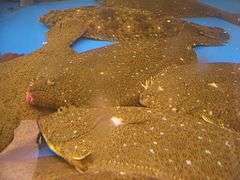Olive flounder
| Paralichthys olivaceus | |
|---|---|
 | |
| Korea flatfish in a supermarket display tank | |
| Scientific classification | |
| Kingdom: | Animalia |
| Phylum: | Chordata |
| Class: | Actinopterygii |
| Order: | Pleuronectiformes |
| Family: | Paralichthyidae |
| Genus: | Paralichthys |
| Species: | P. olivaceus |
| Binomial name | |
| Paralichthys olivaceus (Temminck & Schlegel, 1846) | |
The olive flounder, bastard halibut or Japanese halibut (Paralichthys olivaceus) is a temperate marine species of large-tooth flounder native to the north-western Pacific Ocean.
It is often referred to as the Japanese flatfish or Korea(n) flatfish (광어) when mentioned in the context of those countries.
It reaches a length of 103 cm (41 in) and a weight of 9.1 kg (20 lb).[1]
Aquaculture
The olive flounder is the most common flatfish species raised in aquaculture in Korea. They are raised in Japan and China as well. It is the most highly prized of the Japanese flounders. Although the aquaculture for the olive flounder started from the late 1980s, its commercial production didn't begin on a major scale until the 1990s in Korea.
Parasites and food poisoning
_muscles.tif.jpg)
The Myxozoan Kudoa septemlineata has been described in 2010 from olive flounder from Korea.[2] This microscopic parasite infects the trunk muscles of the olive flounder where it causes myoliquefaction. Ingestion of raw fish containing K. septemlineata spores has been reported as a cause of food poisoning (gastroenteritis) in Japan since 2003.[3][4] However, laboratory studies performed in 2015 and 2016 on adult[5] and suckling mice[6] showed that K. septemlineata spores were excreted in faeces and did not affect the gastrointestinal tract.
References
| Wikimedia Commons has media related to Paralichthys olivaceus. |
- ↑ Froese, Rainer and Pauly, Daniel, eds. (2014). "Paralichthys olivaceus" in FishBase. May 2014 version.
- ↑ Matsukane, Yuuki; Sato, Hiroshi; Tanaka, Shuhei; Kamata, Yoichi; Sugita-Konishi, Yoshiko (2010). "Kudoa septempunctata n. sp. (Myxosporea: Multivalvulida) from an aquacultured olive flounder (Paralichthys olivaceus) imported from Korea". Parasitology Research. 107 (4): 865–872. ISSN 0932-0113. doi:10.1007/s00436-010-1941-8.
- ↑ Kawai, T.; Sekizuka, T.; Yahata, Y.; Kuroda, M.; Kumeda, Y.; Iijima, Y.; Kamata, Y.; Sugita-Konishi, Y.; Ohnishi, T. (2012). "Identification of Kudoa septempunctata as the Causative Agent of Novel Food Poisoning Outbreaks in Japan by Consumption of Paralichthys olivaceus in Raw Fish". Clinical Infectious Diseases. 54 (8): 1046–1052. ISSN 1058-4838. PMID 22281845. doi:10.1093/cid/cir1040.
- ↑ Iwashita, Yoshiaki; Kamijo, Yoshito; Nakahashi, Susumu; Shindo, Akihiro; Yokoyama, Kazuto; Yamamoto, Akitaka; Omori, Yukinari; Ishikura, Ken; Fujioka, Masaki; Hatada, Tsuyoshi; Takeda, Taichi; Maruyama, Kazuo; Imai, Hiroshi (2013). "Food Poisoning Associated with Kudoa Septempunctata". The Journal of Emergency Medicine. 44 (5): 943–945. ISSN 0736-4679. doi:10.1016/j.jemermed.2012.11.026.
- ↑ Ahn, Meejung; Woo, Hochoon; Kang, Bongjo; Jang, Yeounghwan; Shin, Taekyun (2015). "Effect of oral administration of Kudoa septempunctata genotype ST3 in adult BALB/c mice". Parasite. 22: 35. ISSN 1776-1042. PMC 4668110
 . PMID 26630307. doi:10.1051/parasite/2015035.
. PMID 26630307. doi:10.1051/parasite/2015035. 
- ↑ Jang, Yeounghwan; Ahn, Meejung; Bang, Hyojin; Kang, Bongjo (2016). "Effects of Kudoa septempunctata genotype ST3 isolate from Korea on ddY suckling mice". Parasite. 23: 18. ISSN 1776-1042. PMC 4828580
 . PMID 27067108. doi:10.1051/parasite/2016020.
. PMID 27067108. doi:10.1051/parasite/2016020. 